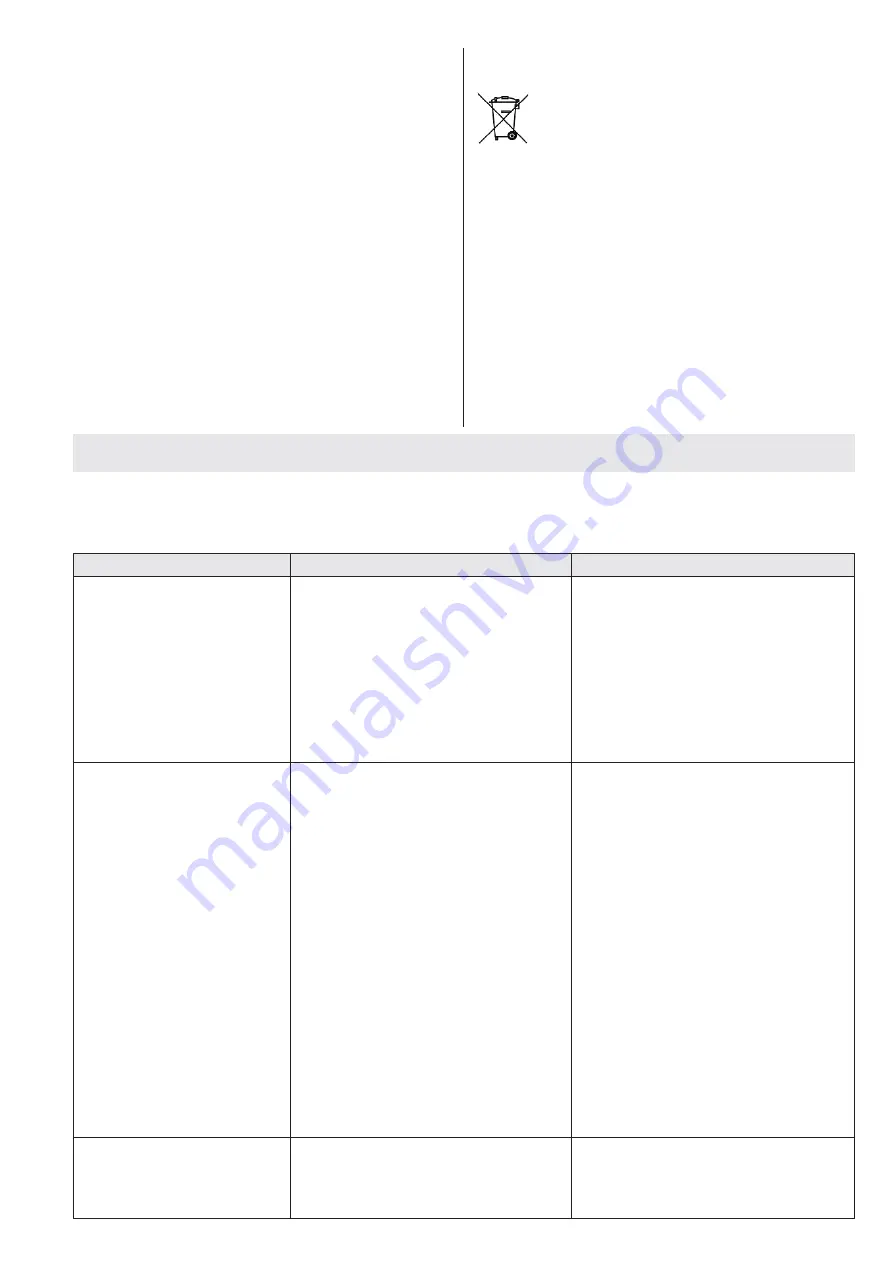
20
TREATMENT OF WASTE FROM ELECTRIC/
ELECTRONIC EQUIPMENT
Dispose of the product in accordance with
current regulations concerning differen-
tiated waste disposal in dedicated waste
disposal areas.
Do not treat as simple urban waste.
For any information please contact the manu-
facturer at the address specified in the user ma-
nual.
The product complies with the requirements of the
new directives introduced for the environmental
safeguard and must be disposed of appropriately
at the end of its life cycle.
When bringing back into use, ensure that there are
no cracks or cuts in the water supply hoses.
Oil and chemical products must be disposed of
according to current legislation.
SCRAPPING
If you decide that the cleaner is no longer to be
used, render it inoperative by removing the electric
power cable. Ensure that all parts of the cleaner
that could be a source of danger are made har-
mless, especially for children who might use the
old cleaner for play. As the cleaner is considered
special waste, dismantle it and divide the material
according to type, then dispose of them as required
by the legislation in force.
Do not use parts dismantled for scrap as
spare parts.
IMPORTANT:
For maintenance and/or repairs, use only original
spare parts which offer the greatest characteristics
of quality and reliability. Failure to use original
spare parts frees the manufacturer from all re-
sponsibility.
FAULTS
CAUSES
REMEDIES
When the switch is turned
the cleaner does not start.
Faulty electric connection.
Thermal protection has tripped.
The omnipolar switch has tripped.
Check the mains voltage.
Reset (if it trips again, apply to the
technical service centre).
Reset (if it trips again, apply to the
technical service centre).
No jet delivered.
Faulty water circuit connection.
Clogged water filter.
Mains tap turned off.
Detergent tap turned on.
Check it.
Clean it.
Turn it on.
Turn it off.
The pump turns but does not
reach the rated pressure.
Water intake filter blocked.
Faulty water circuit connection.
Pressure regulation valve is set at
minimum.
Lance nozzle is worn.
Detergent intake device on the lance
is turned on.
Dirty or worn valves.
Clean it.
Check it.
Regulate it.
Apply to our technical service cen-
tre.
Turn it off.
Apply to our technical service cen-
tre.
When the lance is turned
on the pressure falls and
rises.
The nozzle is clogged or deformed.
Insufficient supply.
Clean or consult our technical service
centre.
Check it.
Insufficient detergent suc-
tion.
Tap turned off.
No detergent in the tank.
Control on the lance not switched
on.
Turn it on.
Fill the detergent tank.
Set the control on the lance.
Presence of water in oil.
Oil seal rings worn.
Apply to our technical service cen-
tre.
Water leaks from head.
Gaskets worn.
Apply to our technical service cen-
tre.
TROUBLE-SHOOTING
Before carrying out any operations, disconnect the cleaner from the power (via the omnipolar switch
or by unplugging the plug from the socket) and water supply.
Summary of Contents for HDEm 662
Page 1: ...HDEm 662 HDEm 962 D EN CZ LV E P DK N SF GR HU ET LT SLO PL RU...
Page 3: ......
Page 85: ...84 i CE Fig 1 Fig 2 Fig 3 Fig 4 I IEC 60364 1 3 kW kW 1 72...
Page 86: ...85 25 250 bar 360 3600 PSI IEC 60364 1 3 mm 3 kW Total stop O 6 7 12 5...
Page 87: ...86 3 Kw 8 8 2 8 BAR 29 116 PSI 50 C 122 F 8C...
Page 88: ...87 3 Kw 3 Kw 1 8 1 2 10 3 4 5 8 Total stop O 13 A B 1 8 2 3 10 simbolo 4 Total stop...
Page 89: ...88 1 2 3 1 2 3 4 8 1 08 7 5 4 1 2 3 16 C...
Page 90: ...89 1 2 6 3 4 5 6 7 8 18 18 50 500 1 18C 2 18 3 4 19 6 W40 20 1 50 500 50 50 200...
Page 148: ...147...
Page 149: ...148 7RWDO 6WRS o p...
Page 150: ...149 c...
Page 151: ...150 o 7RWDO 6WRS o p o p 7RWDO 6WRS...
Page 152: ...151 PXOWLUHJ...
Page 153: ...152 o p o p 6...
Page 154: ...153...
Page 155: ......
Page 164: ...Notes...
Page 165: ......
Page 166: ......
















































